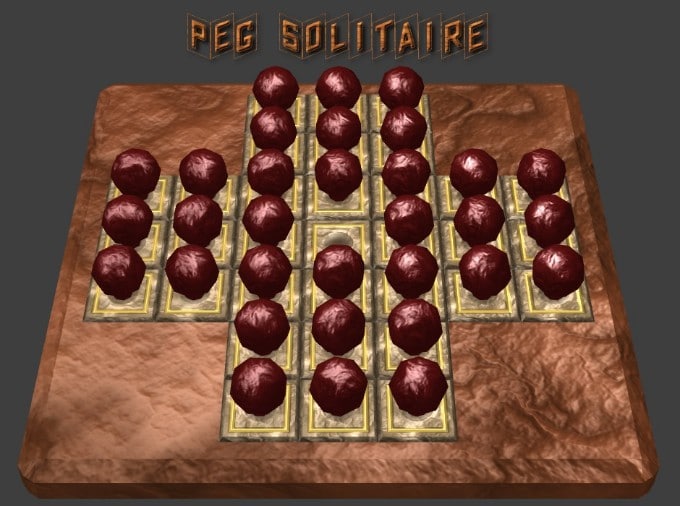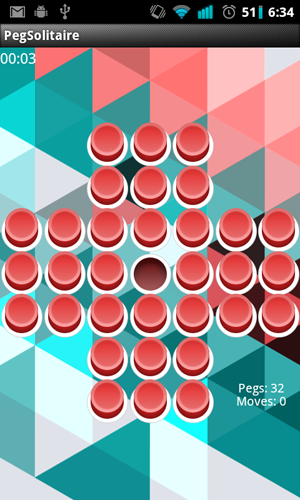

For example, in the goal state below, either the 1 tile or the 4 tile may be moved into the empty upper-left corner. Operator: Any tile (1 to n* n - 1) that is horizontally/vertically adjacent to the empty position may be moved into the empty position. Generating a goal state and then randomly applying the operators described Initial State: An initial state is generated by Position, with 0 representing the empty position. For each grid position, an integer describes the tile at that
#Peg solitaire traingular board java code code
In our version of the puzzle, we code each tile with a number from 1 to n* n Sliding Tile Puzzle Description : The "15 puzzle" is one classicĮxample of sliding square tile puzzles ( ) In addition to turning the center bulb on, this would alsoĬause the bulbs above, below, to the left, and to the right of the bulb to turn However, all lights horizontally/vertically adjacent will also toggle on/off.įor example, in the left figure above, one might select the centermost bulb to Operators: Each light bulb may be selected to toggle on/off. Goal state and then randomly applying the operators described below. Initial State: An initial state is generated by generating a

Scalable Parameter: size of grid ( n-by- n, n Unimplemented Scalable Search Problem Nodes Lights Out Puzzleĭescription: Lights Out is a puzzle where one seeks to get all lights Goal: Exactly 4 units of liquid are in the two buckets. Operators: Fill or empty the first or second bucket, or pour theĬontents of one bucket into the other until the source bucket is empty or the Measure precisely 4 units? With this problem, we use search to develop a plan Buckets Problemĭescription: Given a 5 unit and a 3 unit bucket, how can one Goal: Exactly one peg remains after all others have been removed. This results in the removal of the peg at 8.

State, the peg at 13 could jump the peg at 8 on its way to vacant position 4. Results in the removal of the jumped peg. A peg which jumps overĪn adjacent peg to an empty peg hole immediately beyond in the same direction Initial State: All 15 holes have pegs except for one central vacant Peg holes are in a triangular hex grid as follows: 0 What about a Step-And-Continue callback?.Description: Traditional 5-on-a-side Triangle Peg Solitaire.The Recursive Step and Continue Algorithm.Why No Marshalling Onto The Main Thread?.Step 1: Initializing the FlowSharp modules with the bootstrap loader.We have these brain teaser puzzles at work: We've probably all played them - the idea being you start with one empty hole, the rest are filled with pegs, and each move consists of hopping a peg to an empty location, thus removing the peg you just hopped. The goal is to remain with just one peg left.įor a roomful of programmers, no one (including me!) so far has been able to solve the puzzle. There's a C program here that solves the puzzle.There is a Java article here on CodeProject.Watching one of my coworkers futility go through various failed iterations, I had the obvious thought - write a program to find solutions to the puzzle! The second obvious thought was, someone must have done this! Well, turns out, not really. OK, so while there are several solutions, I actually didn't find one in C#, and even if I had, there is a certain pleasure in writing something like this oneself, even if it's been done before. If you want to play around with recursive yields, there's a YieldTest folder with a simple demo (shown later in the article.).The actual demo app is found in the Demo folder.The SLN file is found in the BrainTeaser folder.Recursive with callback - again the search stack is an artifact of recursion.Recursive using yield - the search stack is an artifact of recursion.Iterative - the search stack is handled as handled as an actual Stack object.Implements three different algorithms so you can peruse the pros and cons of each.As with the actual cheap game, there are 3 different colored pegs - yellow, blue, and red - which the UI implements, randomly assigned when you start the demo.Let's you single step through the solution and watch each step so you can memorize the solution and impress your friends!.Embeds FlowSharp so you can watch the algorithm go through the process of finding a solution (why re-invent the wheel?).Has a funky extension method which may or may not make the code more readable.implemented iteration and recursion alternatives.Īnd as is apt to occur, I went way overboard.had a snazzy UI so you could watch the algorithm processing.Īnd more to the point, none of the algorithms presented: And of course, one can challenge oneself to write the code as elegantly and efficiently as possible, etc.


 0 kommentar(er)
0 kommentar(er)
